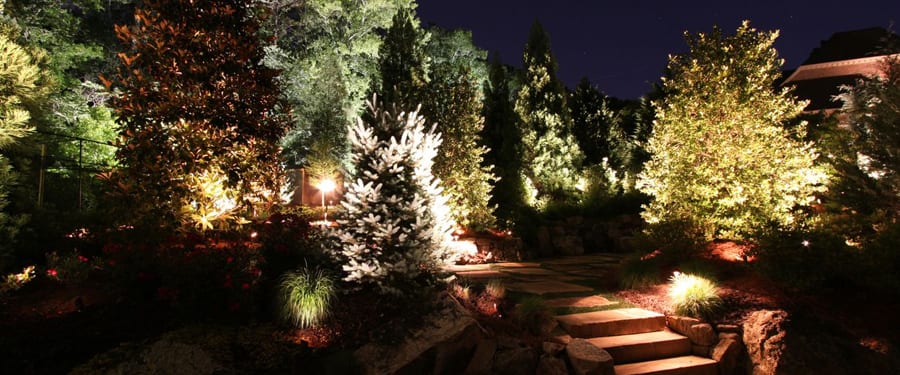There are four concepts to remember when using tree lighting techniques your evergreens with a low voltage outdoor lighting system: light penetration, fixture placement, view point, and Kelvin temperature choice.
Be it a Blue Spruce, an Eastern Hemlock, or even a Ponderosa Pine, these concepts can help you when you’re trying to figure out how to approach and light the evergreens around your home.
Light Penetration
Let’s start with light penetration. Evergreens need to be lit differently than deciduous trees. When up lighting most deciduous trees, the tree lighting is able to penetrate the leaves and branches and travel up to the canopy.
Evergreens, on the other hand, need to be lit differently. If an evergreen were to be lit the same way as a deciduous tree, the light would only be able to travel a few feet before becoming defused. The evergreen’s branches are just too thickly covered in needles for the light to penetrate the whole tree.
The thick needle covered branches of an evergreen can’t be lit from directly below; otherwise, the light will be blocked and defused before it has a chance to travel up through the tree. The last thing you want to do is create a bright hot-spot at the tree’s base.
Instead of being lit from directly below, pines should be lit from a distance with a 60-100° beam spread. Not an extreme distance mind you. Three to ten feet back from the tree trunk will work.
The distance back will depend on the size of the tree. The larger the tree, the further back the directional up light will need to be to capture the tree.
Fixture Placement
Fixture placement is important for a few reasons. As we just mentioned, the fixture placement can depend on the size of the tree.
We move the fixture back depending on the tree size, with towering evergreens being lit up-ward directly from the base.There is another reason why fixture placement is important. When a new young sapling is planted, it can be tempting to place the light fixtures too close to the tree.
While it’s important that the fixture placement is correct and appropriate for the size of the tree, be mindful of what will happen as the tree continues to grow. As the tree grows, so does the radius and spread of its branches.
When the fixtures are placed a mere two to three feet away from the tree, the tree’s branches will grow over and around the fixtures in only a few years.
The last thing you want is for your lights to become engulfed by low-hanging tree branches. Every couple of years it will be important to service your system and continuously move your fixtures back so they will light your tree appropriately.
View Point
No matter what kind of tree lighting you are doing, you need to ask yourself what your visual aspect is. Where will the object be viewed from when it’s illuminated? Figuring this out with evergreens is extremely important.
This could be your back patio, the road in front of your home, or the view you have looking out the dining room window. To light evergreens correctly it can often require more than one light; knowing where the tree will be viewed should help you figure out how many lights need to be used.
Wide and robustly shaped, a large established Spruce or Canadian hemlock could require three to five lights to wash properly. Understanding where the tree will be viewed will help you determine how much of the tree will need to be lit, and in turn, how many lights will be needed to create that effect.
Kelvin Temperature
Kelvin temperature, put simply, is the hue or color temperature of the LED lamp. With deciduous trees we prefer to use a warmer 2700 Kelvin lamp.
When it comes to evergreens, however, we prefer to use a cooler 3000-3500 Kelvin lamp. This lamp is less yellow/warm and more cool/white. We use this Kelvin temperature on evergreens because it helps pull out those dark green tones in the pine needles.
To learn more about how to light your outdoor living space, contact NightVision today or give us a call at 678-828-2999



